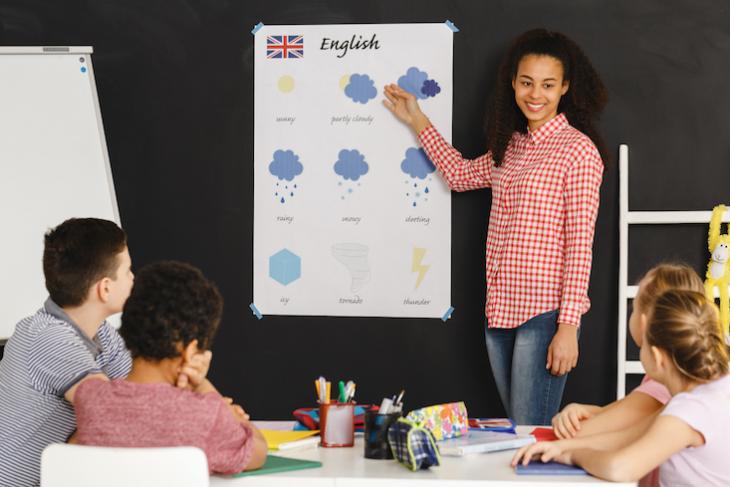Are you a new teacher gearing up for your first ESL classroom?
I’ve been in your shoes before – I taught abroad in the UAE for six years and have been teaching English language learners (ELLs).
Teaching English in the classroom to students who have a limited English language understanding can feel like a daunting task.
But at its core, teaching ELLs isn’t really all that different from teaching fluent speakers.
How can that be possible?
The same basic principles should apply to any good classroom: a lesson should be organized, engaging, and catering to students’ different learning needs.
Sure certain unique challenges come with teaching English online or in a foreign language classroom.
Teaching students from an array of cultures, learning styles, educational backgrounds, along with a language barrier, take some getting used to.
So you can come to your first classroom prepared, here are 12 little-known ESL classroom tips and teaching strategies for English language learners:
- Connect with your students.
- Create a safe learning environment.
- Establish routines.
- Speak slowly and enunciate words.
- Use non-verbal communication.
- Make things visual.
- Check for understanding.
- Be adaptable.
- Create engaging lessons.
- Introduce new vocabulary before use in lessons.
- Practice differentiated teaching strategies.
- Learn about your students’ cultural backgrounds.
- Incorporate technology.

1. Connect with your students.
Picture this: you’re a student sitting in a class with a stranger at the front of the classroom who speaks a foreign language you can hardly understand.
It can be intimidating when the teacher launches right into their lesson without an ice breaker.
It’s important to remember that students (especially kids) don’t learn from people they aren’t comfortable with.
Introduce yourself. Ask questions or do an icebreaker. Get to know your students before you get started.
Learn and address your students by name, greet each student and make a genuine effort to get to know them.
Building a rapport will go a long way in creating strong relationships with your students and will help them learn better.
2. Create a comfortable learning environment.
Students need to feel safe and secure to express themselves fully.
By creating a positive learning environment, not just physically but emotionally, students will be more willing to try new things.
And, more importantly, practice their English language skills.
Correct errors with compassion. ELL students are bound to make mistakes – that’s how they learn!
Try positive reinforcement strategies. Reward good work and effort. Positive reinforcement is a great way to make students feel safe but build a rapport.
It’s also essential to give students time to finish their work and answer questions, so be patient!
Keep in mind that ELL students will most likely need to translate questions, formulate an answer and then translate it back to English.
That whole process can take a bit of time, so it’s important to give students a chance to think it through rather than demanding a quick answer.
Using teaching strategies like Think-Pair-Share will give students time to process information, answer confidently and increase participation.
Considering getting TEFL certified? Look into TEFL certifications that offer additional specializations in teaching English to young learners for more help.
3. Establish routines.
ESL students thrive with routine and structure.
Writing a daily agenda, having circle time or a sit-down activity for students when they enter the classroom will help students become familiar with their lesson plans.
Just make sure to post clear objectives.
ELL students need to understand the purpose or end goal of the activity or lesson to comprehend the lesson’s content.
Using examples is a great way to bridge the gap between communicating objectives and student comprehension.

4. Speak slowly and enunciate words.
Slow down! You’re going to want to reduce your talking speed so that everyone in the class has a chance to hear every word you say.
A lot of language learners will agree that fluent speakers speak too fast. It can be hard to understand the whole message when you didn’t catch all of it.
Try to be mindful of the speed of your voice. And try to speak as clearly as possible by enunciating your voice.
Speak louder than you usually would.
It’s really important that your students can learn how to pronounce vocabulary and hear all the nuances of a word.
5. Use non-verbal communication.
Time to flex your acting chops! Get creative and use your body language to express an action during a lesson.
One of my favorite tricks to help students learn important grammatical rules like prepositions is to use my body as a prop when using the word.
For example, you can demonstrate each preposition by acting it out. When I say “in” I act out the action of putting something in my mouth and repeat patterns. Repetition helps people remember!
Tip: the more outlandish the action, the easier it is for them to recall it later.
You may also play a game of charades with your students!

6. Make things visual.
Make learning English interesting and fun, so it’s stickier.
One way to do that is by engaging learners with visuals or props. Bring your lesson plan to life by drawing on the board or sharing pictures, videos and art.
Label everything! The label maker is your new best friend.
Using labels on everyday classroom resources (like chairs, doors, desks, computers, pencils, etc.) will help students absorb new English vocabulary.
Also, word walls are a great way to create print-rich environments.
I highly recommend building a visual wall where words are accompanied by a picture to help students match meanings with words.
7. Check for understanding.
Think your students are gonna stop you in the middle of a sentence and ask for clarification when they don’t understand? Think again!
Most language learners get shy about admitting to the whole class they didn’t understand something.
You’d be surprised how many students pretend they understood when they have no idea what you’re talking about.
That’s why you should remember to pause after you say something or give instructions to check for understanding.
Ask a few more questions or explain the context a little more before you move on to make sure they took it in.
8. Be adaptable.
Teaching in an ELL classroom can be unpredictable. That’s why you’ll want to learn multiple ESL teaching methods.
I remember working so hard preparing a lesson plan only to be met with a class full of blank stares.
I thought maybe the activity’s point wasn’t clear, so I adjusted my explanation, but I still got glares of confusion no matter what.
It’s essential to bear in mind that lesson activities can (and will) fall flat on many occasions.
That’s why I learned to be flexible with my lessons and prepare multiple ways to teach a specific concept in advance. Preparation is key!
Side note: The phrase, “do you understand?” should never, in my opinion, be uttered in an ESL/ELL classroom. Students are frequently eager to please their teacher and will almost always answer this question in the affirmative.
Need help coming up with a lesson plan? Check out some of our favorite free ESL lesson plans.

9. Create engaging lessons.
Small practices that we, as fluent English speakers, can take for granted can make learning English a whole lot easier and more enjoyable.
Make your lessons engaging and interactive for your students.
Do everything out loud (think alouds!) and make sure to demonstrate concepts in multiple ways to increase student understanding and reach various learning styles.
Using visuals, close activities and graphic organizers can all aid ELL students in their learning.
I would often teach the same concept multiple times using different strategies such as singing, videos, actions, stories, etc.
By the time I had returned home from teaching abroad, I was no longer just a teacher – I was an actress, singer and author, too (ok, maybe I’m getting ahead of myself!)
10. Introduce new vocabulary before use in lessons.
As part of my regular classroom routine, I created a list of words that were related to the weekly themes.
At the beginning of each week, we’d go through each word, discussing the meaning and practicing its use in sentences.
Each word was posted for the week at the front of the classroom, along with a visual conveying meaning.
My students were able to have a quick point of reference and memorize words easier.
Learning vocabulary first, freed them up to focus on the overall learning objectives of the lesson.
After the week was up, I’d post each new word on the word wall built up throughout the entire school year.

11. Practice differentiated teaching strategies.
Teaching languages taught me the importance of differentiation.
This means tailoring your lessons to meet your students’ individual needs for those who don’t know.
It’s not just for students with special needs or individualized educational plans, but it’s also for mainstream students that find themselves below, at and above grade level.
Differentiation goes so much further than having high, medium and low leveled worksheets and activities.
I was able to differentiate my lessons by:
- Product: allowing students to choose how to display their learning.
- Process: creating activities that appealed to multiple learning styles.
- Content: leveling outcomes and activities based on ability.
Providing students with a choice in learning increased student engagement in my classroom.
I used a lot of center-based, hands-on learning activities. I also found grouping students in mixed ability and ability groupings helped them work more independently.
For more ideas, check out websites that provide lesson plans and resources for teachers, including:
- Education.com
- Scholastic
- Share My Lesson
- Learning Games For Kids
- ESL Games and Activities for Online English Teachers
All of these great resources are designed to help enhance the student learning experience in your classroom.
12. Learn about your students’ cultural background.
ELL students need to retain recently acquired English vocabulary by relating it to their own real-life experiences to store it in their long-term memory.
Make sure to do some research before going to your international teaching destination and familiarize yourself with your students’ culture, customs, and everyday lives.
Use that knowledge in your classroom to help students retain vocabulary and abstract concepts.
If you’re looking for practical ways to help create a more culturally responsive classroom, check out Teach Away’s professional development course for teachers, Culturally Responsive Teaching: Connecting with students and parents of different cultures.

13. Incorporate technology.
We live in a digital world. Kids nowadays are growing up in a world dominated by technology tools and apps.
Incorporating digital tools and technologies into your curriculum and lesson plans is a great way to reach and engage digitally-savvy students in more creative ways.
So, how can you grow your digital skills as well as those of your students?
Get started by trying out some free classroom apps like ClassDojo and Quizlet.
We also launched an online course for teachers to help bring digital literacy and learning into the classroom, Digital Learning for the K-8 Classroom, in partnership with Teachers College, Columbia University.



